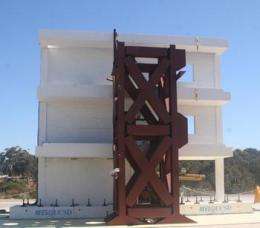Retrofitted Historic Building Survives Strong Simulated Jolts During UCSD Test (w/ Video)

(PhysOrg.com) -- When a series of rigorous simulated earthquakes - measuring up to a 7.5 magnitude - jolted the three-story, 1920s era reinforced concrete structure, UC San Diego engineers were not quite sure what would happen. The structure suffered some damage but it was still standing - just what the engineers had hoped for.
As part of the $1.24 million research project sponsored by the National Science Foundation under the Network for Earthquake Engineering Simulation (NEES) program, the three-story, masonry-infilled, reinforced concrete frame representing structures built in California in the 1920s was tested at the NEES -UCSD Englekirk Structural Engineering Center, home of the world’s largest outdoor shake table. The structure had an unreinforced masonry wall at the bottom story retrofitted with an engineered cementitious composite (ECC). Currently, there is a lack of reliable analysis methods to evaluate the seismic performance of these older masonry structures and validated retrofit methods to improve their seismic behavior. The ultimate goal of this project is to provide methods to assess and improve the seismic performance of these older buildings by developing reliable analytical models and effective retrofit techniques.
Many reinforced concrete (RC) and steel frame structures have unreinforced masonry infill walls to serve as interior and exterior partitions. Such construction can be found in many older buildings in the western United States, including pre-1930’s buildings in California, and in numerous newer buildings in the midwestern and eastern parts of the country. In fact, RC frames with brick infill are common construction practice in many parts of the world, such as China and Mediterranean countries. However, in spite of the fact that unreinforced masonry infill walls are usually treated as non-structural components, they will interact with the bounding frames when subjected to earthquake loads, explained Benson Shing, a UCSD structural engineering professor and lead researcher on the project.
“When these structures are subjected to severe seismic loads, the interaction of the frame and infill walls can lead to undesired failure mechanisms, such as the brittle shear failure of the columns and the cracking and collapse of the brick infill walls,” Shing said. “The two-bay, three-story frame had one of the bottom-story bays open without any brick infill. This configuration would normally introduce a weak bottom story, which could lead to a catastrophic failure.”
The main focus of the recent tests - which were performed in collaboration with Stanford University, and the University of Colorado at Boulder - was to evaluate the effectiveness of two retrofit techniques intended to enhance the seismic performance of these structures. One is the use of an overlay of an engineered cementitious composite (ECC) material to restrain the cracking of the brick walls, and the other is the use of a thin overlay of a glass fiber reinforced polymeric (GFRP) material for the same purpose. The ECC material consists of cement, sand, glass fibers, and other additives. The surface of the glass fibers is specially treated to enhance the tensile ductility of the cement-fiber composite. The ECC material was applied onto the infill wall in the bottom story of the test structure, and the GFRP overlay was used on the second-story walls, one of which had a window opening.
“The interaction of the concrete frame with a masonry wall is a complicated physical phenomenon,” Shing said. “ So we try to predict with more precision with advanced computation models; we hope these tests will provide data that will allow us to validate these models so we can use them in the future to study the performance of similar types of construction and structures with different configurations such a different number of stories.
Shing said despite intense shaking of the structure, the retrofit proved very successful. The recent shake tests were a follow-up to seismic tests conducted by Shing and his team on a similar structure on the shake table at the UCSD Englekirk Center in November 2008.
During the November 2008 tests, the engineers subjected a 3-story structure with a non-ductile reinforced concrete frame and unreinforced masonry infill walls. Infill walls can generally improve the seismic safety of a building up to a certain level of earthquake intensity depending on the number of walls present and their locations. Once the strength of the walls is exceeded by the earthquake force, the failure of such structures could be sudden and catastrophic.
The video below shows the severe damage to the three-story structure that occurred during the November 2008 tests.
“We have seen that the retrofit does improve the performance of the structure compared to first specimen we tested last November,” Shing said. “We performed the most recent tests to see whether we could enhance the seismic safety of a structure that does not meet current code standards using cost-effective retrofit measures."
The researchers are now evaluating all the test data, which will be used to develop analytical computer models that will be used to predict the behavior of these types of buildings design and to evaluate retrofit measures for structures of different configurations and design details.
Shing and his Ph.D. students Andreas Stavridis and Ioannis Koutromanos, who also helped lead both shake tests, will present their findings in a paper titled, “Seismic Performance of Non-Ductile RC Frames with Brick Infill,” during a conference organized by the Applied Technology Council and Structural Engineering Institute, “Improving the Seismic Performance of Existing Buildings and Other Structures” in San Francisco in December.
Provided by University of California - San Diego (news : web)





















